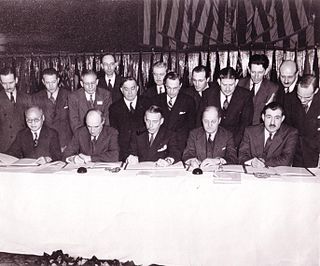The Single European Sky (SES) is a European Commission initiative that seeks to reform the European air traffic management system through a series of actions carried out in four different levels with the aim of satisfying the needs of the European airspace in terms of capacity, safety, efficiency and environmental impact.
The Air Commerce Act of 1926 created an Aeronautic Branch of the United States Department of Commerce. Its functions included testing and licensing of pilots, certification of aircraft and investigation of accidents.

The Convention on International Civil Aviation, also known as the Chicago Convention, established the International Civil Aviation Organization (ICAO), a specialized agency of the United Nations charged with coordinating international air travel. The Convention establishes rules of airspace, aircraft registration and safety, security, and sustainability, and details the rights of the signatories in relation to air travel. The convention also contains provisions pertaining to taxation.

The Constitution Alteration (Aviation) Bill 1936, was an unsuccessful proposal to alter the Australian Constitution to extend the Commonwealth legislative power in respect to air navigation and aircraft. It was put to voters for approval in a referendum held on 6 March 1937.
The Civil Aviation Safety Authority (CASA) is an Australian statutory authority responsible for the regulation and safety oversight of Australia's civil aviation. CASA was formed on 6 July 1995 under the Civil Aviation Act 1988 when the Civil Aviation Authority was split into two separate government bodies: Airservices Australia and CASA.

ENAIRE is the air navigation manager in Spain, certified for the provision of enroute, approach and aerodrome control services. As a public corporate entity attached to the Spanish Ministry of Public Works, it is responsible for air traffic control, aeronautical information and the communication, navigation and surveillance networks so air companies and their aircraft can fly safely and in an organised format within Spanish airspace.

The European Organisation for the Safety of Air Navigation, commonly known as Eurocontrol, is an international organisation working to achieve safe and seamless air traffic management across Europe. Founded in 1963, Eurocontrol currently has 41 member states with headquarters in Brussels, Belgium. It has several local sites as well, including an Innovation Hub in Brétigny-sur-Orge, France, the Aviation Learning Centre (ALC) in Luxembourg, and the Maastricht Upper Area Control Centre (MUAC) in Maastricht, the Netherlands. The organisation employs approximately two thousand people, and operates with an annual budget in excess of half a billion Euro.
The Canadian Aviation Regulations (CARs) are the rules that govern civil aviation in Canada.

The Civil Aviation Authority of the Philippines is the civil aviation authority of the Philippines and is responsible for implementing policies on civil aviation to assure safe, economic and efficient air travel. The agency also investigates aviation accidents via its Aircraft Accident Investigation and Inquiry Board. Formerly the Air Transportation Office, it is an independent regulatory body attached to the Department of Transportation for the purpose of policy coordination.
A civil aviation authority (CAA) is a national or supranational statutory authority that oversees the regulation of civil aviation, including the maintenance of an aircraft register.
The Directorate General of Civil Aviation (DGCA) is a statutory body of the Government of India to regulate civil aviation in India. It became a statutory body under the Aircraft (Amendment) Act, 2020. The DGCA investigates aviation accidents and incidents, maintains all regulations related to aviation and is responsible for issuance of licenses pertaining to aviation like PPL's, SPL's and CPL's in India. It is headquartered along Sri Aurobindo Marg, opposite Safdarjung Airport, in New Delhi. The Government of India is planning to replace the organisation with a Civil Aviation Authority (CAA), modelled on the lines of the American Federal Aviation Administration (FAA).

The Civil Aviation Authority of Fiji (CAAF) is the civil aviation authority in the Republic of Fiji and is responsible for discharging functions on behalf of the Government of Fiji under the States responsibility to the Convention on International Civil Aviation, also known as the Chicago Convention on International Civil Aviation Organization (ICAO). CAAF regulates the activities of airport operators, air traffic control and air navigation service providers, airline operators, pilots and air traffic controllers, aircraft engineers, technicians, airports, airline contracting organisations and international air cargo operators in Fiji.
BULATSA is the Bulgarian Air Traffic Services Authority, a branch of the Bulgarian Civil Aviation Administration responsible for air traffic management within Bulgaria's airspace.






